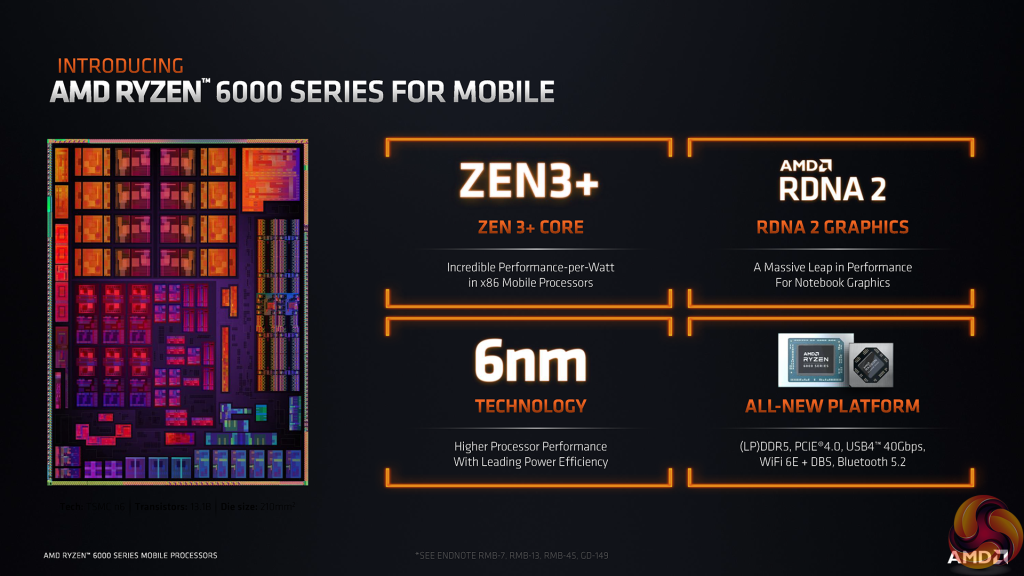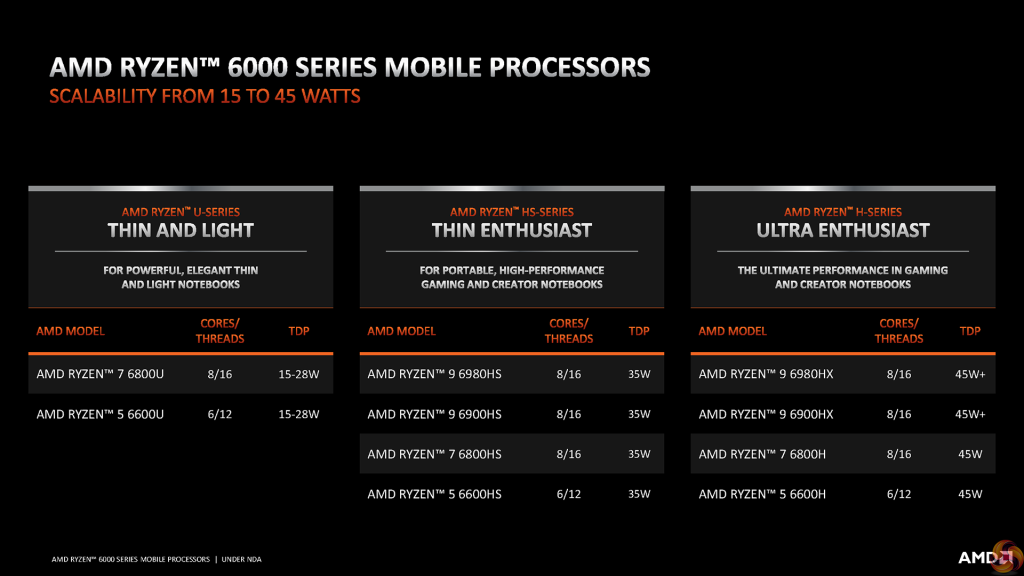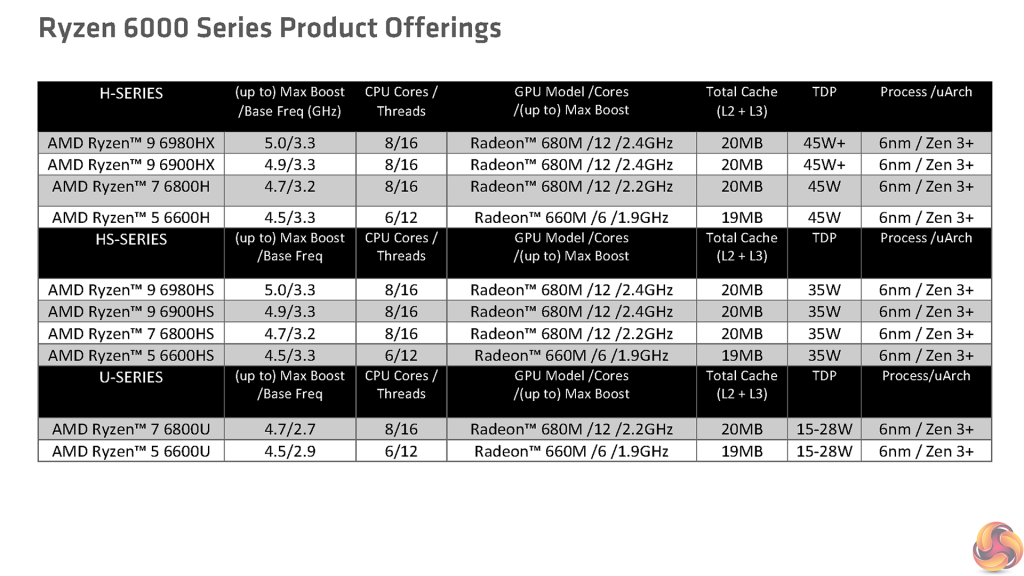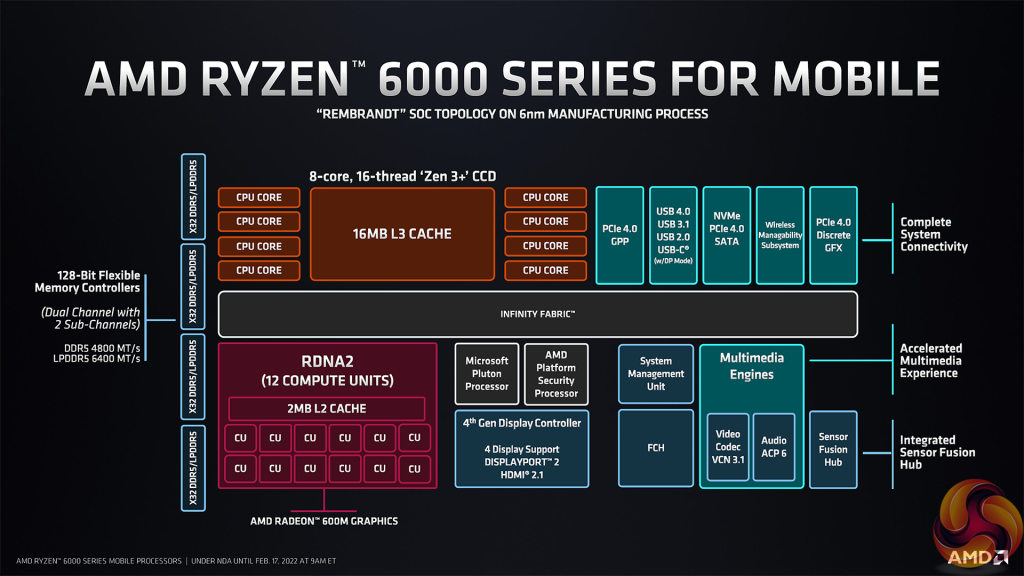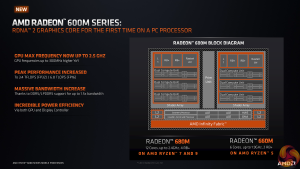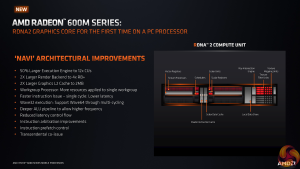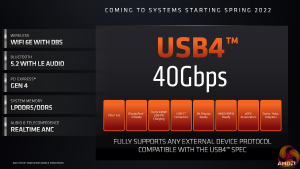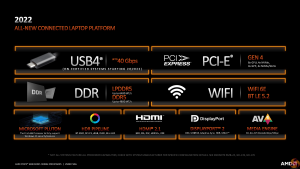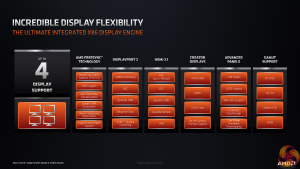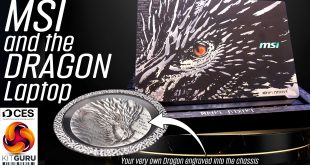Laptops powered by the new Zen 3+ ‘Rembrandt’ AMD Ryzen 6000 Mobile series processors have released today, marking the introduction of RDNA2 iGPUs, TSMC’s 6nm process node, and DDR5 memory to the world of AMD-based notebooks.
Our ASUS ROG Zephyrus G14 sample – that is powered by the brand new Ryzen 9 6900HS processor and RX 6800S dGPU – is currently stuck in a European shipping depot. But for now, we will be examining the new technologies and features brought to the table with AMD’s introduction of the Ryzen 6000 Series mobile processors.
There are a few key features to highlight with Ryzen 6000 Series Mobile processors, and then some intricate details about the microarchitectural power optimisations that we will highlight later in this article.
Processor Features and Specifications:
First up are the core specifications of the processors themselves. AMD once again splits the Mobile line-up into U-series (15-28W TDP), HS-series (35W TDP), and H-series (45W+ TDP) options.
The flagship chip for each series has eight Zen 3+ cores and 16 threads, but they differ by their TDP-induced clock speeds and iGPU performance. There are also six-core, 12-thread Ryzen 5 options for U-, HS-, and H-series deployment.
As a side note, performance density for Ryzen 6000 should be improved versus Ryzen 5000 by way of greater transistor count, despite its (not proportionately) larger die area. Ryzen 6000 Mobile Series is 13.1 billion transistors at 210mm2, whereas Ryzen 5000 Mobile Series was 10.7 billion transistors at 180mm2.
For the H- and HS-series parts that utilise 35W+ TDPs, base clocks are 3.2GHz or 3.3GHz, with boost frequencies as high as 5.0GHz as you move up to the flagship options. Understandably, the U-series cranks this down a little with base clocks coming in shy of 3GHz and boosts around the mid-4GHz level.
Inside the 8-core Zen 3+ CCD, you still get the same 16MB slice of L3 cache that we saw with Zen 3. And that blends in with the 0.5MB of L2 cache per core that we are accustomed to. There are differences in how AMD uses the cache for Zen 3+, but in terms of quantities, it is much the same as raw Zen 3.
Where there has been a significant change is in the integrated graphics department. Finally, AMD has upgraded the on-chip cores to RDNA2 in its 12 Compute Unit form for Radeon 680M (6 CUs for Radeon 660M inside Ryzen 5).
Coined AMD Radeon 600M series, the ‘Navi’ architectural improvements that we have seen since 2019 on the desktop are now onboard the Mobile chips. This represents a huge upgrade versus the aged Vega-based CUs on AMD’s previous generation Mobile processors. Doubled L2 cache capacity, higher frequencies, and a larger render backend are just some of the notable improvements from RDNA2.
Speaking of higher frequencies, the Ryzen 9 chips now see maximum GPU frequencies as high as 2.4GHz which translates into 3.4 Teraflops FP32 peak performance. AMD is actually comparing gaming performance to something like a GTX 1650 Max-Q in the slides. But obviously that will require additional scrutiny from independent testing.
And feeding the higher performance graphics cores with higher memory bandwidth is achievable thanks to support for DDR5 and LPDDR5. This is AMD’s first consumer platform to support the latest memory technology, and the bandwidth that the higher speed DRAM brings has been highlighted as critical for integrated graphics performance.
The chip’s 128-bit flexible memory controllers permit support for DDR5-5200 4800 MT/s (Ed.: reference to 5200 MT/s in AMD's documents is a typo. 4800 MT/s is the correct supported DDR5 speed) and LPDDR5 6400 MT/s. This is good to see, especially with the memory bandwidth that on-chip support for 4800MHz+ frequencies permit.
Another key improvement – this time on the SoC side of things – is via enhanced connectivity support. And perhaps the star of that show is USB4.
Now, AMD is clear in highlighting that this is still in the stages of certification for many systems. But we will start to see certified systems in March, and some current hardware is shipping with USB4-enabled components that can be activated via updates.
Now it must be made clear that USB4 supports interoperability with Thunderbolt. But this is at the manufacturer’s discretion, so not all laptops will technically support TB hardware such as docks. In isolation, however, USB4 can offer many of the same features as Thunderbolt; up to 40Gbps transfer speeds, DisplayPort and PCIe tunnelling, and power delivery if deployed as USB-PD. But, once again, these features will differ based on the individual laptop.
PCIe Gen 4 support through the platform is finally added by AMD. You get eight lanes for a GPU and then twelve lanes additional connectivity for multiple high-bandwidth devices or NVMe SSDs.
This was an absolute necessity for Ryzen 6000 Mobile, as Intel has been offering PCIe Gen 4 on its laptop chips for a long time. And now that Gen 4 NVMe storage and dGPUs are commonplace, it really was a critical upgrade.
And another long overdue upgrade is to the on-chip media capabilities. The new 4th Gen Display Controller offers proper support for HDMI 2.1 (up to 48Gbps) and DisplayPort 2 – in quadruple monitor format, laptop dependent. This enables proper connectivity for 4K120 and 8K60 displays, as well as advanced colour profiles such as 10-bit colour, Dynamic HDR, and Variable Refresh Rate (VRR).
Importantly, the multimedia engines have been upgraded on the video (VCN 3.1) and audio (ACP6) fronts. The video codec was inferior to Intel’s competing – Tiger Lake-U – offerings for Ryzen 5000. So, it is good to see the updated VCN 3.1 deployment which should hopefully improve decode and encode performance.
H.264 8bpc and H.265 8bpc/10bpc hardware encoding is supported, but there’s still no hardware-accelerated VP9 capability. Decode capabilities are thorough, though, and AMD actually highlights on-die 8bpc/10bpc decode for the (still relatively) new AV1 codec.
AMD also highlights support for Microsoft Pluton to enable modern security features in Windows 11.
 KitGuru KitGuru.net – Tech News | Hardware News | Hardware Reviews | IOS | Mobile | Gaming | Graphics Cards
KitGuru KitGuru.net – Tech News | Hardware News | Hardware Reviews | IOS | Mobile | Gaming | Graphics Cards


